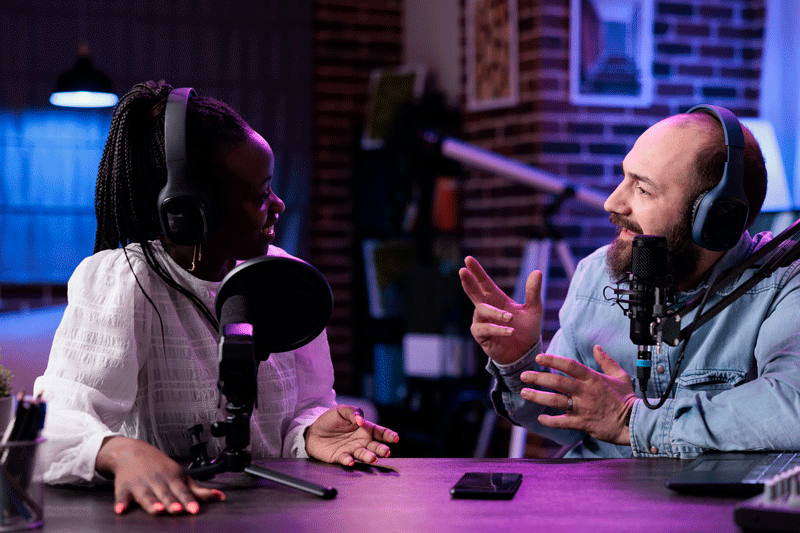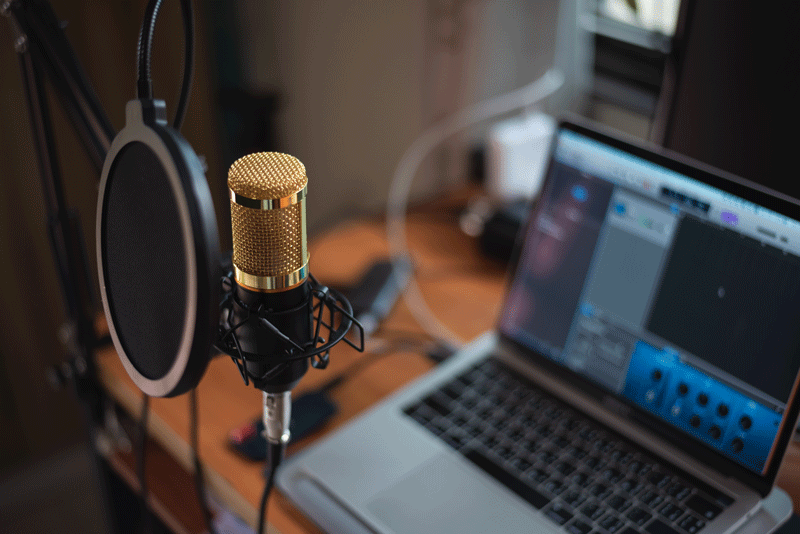When producing your own podcast, it’s essential to maintain audio quality at a professional level so that your listeners enjoy the sound and stay engaged with your content for hours. You want to give them the best listening experience. And it’s not only the quality of recording that you need to maintain at a high level but also the post-production processing of your creation, which is podcast mixing and podcast mastering.
What does mastering a podcast mean?
 In the podcast production process, mastering usually includes mixing. This happens because, most often, a podcast audio recording consists of just a few tracks. Mixing one or two tracks of a podcast, of course, is not as complicated a job as mixing music where for one song there can be 20 or more tracks in a session.
In the podcast production process, mastering usually includes mixing. This happens because, most often, a podcast audio recording consists of just a few tracks. Mixing one or two tracks of a podcast, of course, is not as complicated a job as mixing music where for one song there can be 20 or more tracks in a session.
Because of this relative simplicity, mixing and mastering for podcasts are usually done together. However, it doesn’t mean that for podcasting, you can only do loudness normalization and send your audio recording out to the world, neglecting professional mixing and mastering. There’s still a lot to do with the recording before it will sound truly professional.
In this article, we’ll share with you the steps we take when we work with podcast audio.
Do podcasts need mastering?
A good audio track is carefully prepared for release, which is why when you listen to it, no extra sound bothers you; it’s pleasant to hear, and the loudness is moderate and does not change throughout the podcast.
Here are some of the tasks, that the podcast mastering process is aimed to achieve:
- Clean the recording from all unwanted sounds and background noise
- Attenuate the unpleasant features of each speaker’s voice, remove sibilance with equalization and de-essing
- Enhance the most important frequencies in the speech of each podcast participant, emphasize the individuality of each speaker
- Compress each human voice and glue them together to make all the recording sound coherent
- Do loudness normalization and make sure there will be no clipping distortion
- Ensure smooth loudness transitions throughout the mix with no sudden jumps in volume
- Bring the loudness to the level necessary for distribution on streaming services
The most attention you should pay to the clarity and the volume of the speech. The listener should hear each podcast participant well and like the sound they hear.
The show’s music
 If you think that mastering podcasts is only mastering conversations you are missing one important thing. Podcasts have additional musical parts in them, for which you’ll need to do mixing and mastering as well.
If you think that mastering podcasts is only mastering conversations you are missing one important thing. Podcasts have additional musical parts in them, for which you’ll need to do mixing and mastering as well.
There are intro and outro musical parts, and also musical transitions between the parts of the episode that is called segment changes. The intro sets the mood for the whole conversation. As with their favorite tv show, your audience will love it and wait to hear the music intro to their favorite podcast.
Music can also appear in the middle of the conversation many times as a sound bed for the highlighted parts of the conversation, sponsored advertisements, and others.
The intro, outro, and other musical parts that accompany the conversation, besides the music, may include vocals, speech, and other elements.
Pay special attention to mixing music into your podcast, because the more beautifully and naturally the music intertwines with the conversation, the more it sounds like an integral part of the podcast, and the more pleasant it will be to the listener. At the same time, the intro and the outro should be catchy and professionally made to fit each particular podcast.
You process them as you would normally mix music, adjust volume, unite these parts with the podcast coherently with fade-in and fade-out, and make sure they are not too loud and sound fine with the entire recording.
How do we mix and master a podcast?
We start working on a podcast at our mixing and mastering studio with edits and preparing the tracks. After that goes mastering the loudness and the finishing touches. Let’s see what we usually do step by step.
Step 1. Cleaning the podcast sound
The first step is professional cleaning and preparations.
At this step, we manually remove all accidental extra sounds. Sometimes the microphone can pick up lots of background noise because podcasts are rarely recorded in sound-treated booths.
Sometimes the host or guests may create clicks, knocks, and other accidental sounds that will bother the listener and need to be removed. Accidental clicks and background noise can appear even if you use high-quality recording equipment for your podcasting.
The mastering process is needed to create good audio that’s loud enough and free from anything that will distract or bother the listener.
Step 2. Create an individual track for each participant
It often happens that there’s one microphone for more than one person. The guests and the host take turns speaking into one mic.
If two or more speakers are recorded on a single track, we split them, giving each one their own separate track in the session.
Why do we do this? Each voice is unique and has its own frequency characteristics, so it should be processed and equalized differently. Some people may speak too quietly or in an unclear manner; some voices can have squeaky elements that need to be attenuated.
The bottom line: you’ll definitely benefit from keeping each person’s speech on a separate track.
Want a free test mix of your track?
We get it.
That’s why we’ll do a full hybrid (analog + digital) mix of your song —
for free.
No upfront payment. No risk.
You only pay if you’re blown away. And if you are, we’ll slash 40% off the final price.
Nobody else in mixing and mastering offers this.
Why?
Because most studios say yes to every project. We don’t. We only mix what we’re excited about — so send us your best track. If we like it, we’ll mix it like it’s going to the Grammys.
👉 Just drop your name and email to get started.
Step 3. Enhance the sound quality of every voice
Each timber and specifics of speech require an individual editing approach to enhance the most attractive features of the voice and to suppress the frequencies that are not making the speech better.
This can be achieved by using equalization and noise reduction tools.
At this step, we may use de-esser, which will help to create a more clear and good-sounding speech.
The main role in enhancing the sound quality of the voice and speech plays equalization. We adjust frequency curves differently for each voice in the mix. The task is to eliminate sound issues and make the recording sound smooth, beautiful, and pleasant to listen to.
Step 4. Equalization and compression
 After that, goes standard vocal mixing.
After that, goes standard vocal mixing.
We do low-cut, apply a high-pass filter, add energy in high frequencies, and use gates if necessary.
We can apply some noise-shaping tools, or use R-Vox and add a little compression.
Watch out for the traces of pops, clips, sibilance, or other unwanted sounds, and remove them using EQ.
Multiband compression makes a huge difference at this step. It helps to make sure all the frequencies are presented in the record well.
Step 5. Glue the dialog together
In the end, we even out the recording.
The volume of speech must stay the same throughout the whole conversation.
There should not be too quiet parts as well as jumps in volume. The listener will most probably listen in headphones and they prefer to have the same loudness from the beginning to the end of the podcast.
Another tool we recommend is some kind of algorithmic equalizer like Soothe2 or DSEQ. Those equalizers will help glue the podcast together regarding the frequency picture of the speech.
If the podcast is in stereo, always check if mono sounds perfect.
Step 6. Mastering podcasts: How many LUFS should a podcast audio be?
At this step, we are going to do mastering. With podcast mastering, we bring the loudness of the podcast to the integrated LUFS level that is loud enough for distribution.
Our recommendation for the perfect targeted loudness for podcasts is from -18 LUFS to -15 LUFS. Many engineers suggest -16 LUFS is the perfect integrated perceived loudness for a podcast master.
The final audio level of the episode you master makes all the difference, because you may upload your podcast to a platform that doesn’t use normalization, or only turns the volume down as YouTube does. So the loudness level you master to really matters here.
Why do loudness wars not apply to podcasting?
Loudness wars mean a lot in today’s pop music. Even though most music platforms normalize the perceived loudness to -14 LUFS or -16 LUFS, most pop music still is mastered much louder than that in an attempt to impress the listener.
However, when people switch to your podcast, it shouldn’t jump right at the listener being much louder than the previous recording they listened to. All the other podcasts your audience will listen to will be using roughly the same loudness level and yours shouldn’t make an exception.
Your podcast volume must not be significantly higher or lower compared to the audio levels of others, this way the listener will experience a comfortable transition from other material to your podcast and will be happy to listen to start listening to it.
On the other hand, platforms like Apple Music and Spotify will play your audio with a normalized volume. But don’t worry, this normalization process brings no distortion to your final product audio, and only makes all the material sound on the same integrated LUFS level, so the volume of your podcast will be even more standardized.
Step 7. Apply final limiter
In the end, you may add a brickwall limiting to -6 dB or -3 dB, as you like, to make sure you haven’t missed any peaks.
Podcasts can be long and last for two or three hours. And even though preparing them is relatively easy compared to songs, still in a 3-hour final product you can miss something even if you were listening carefully.
The final limiter will definitely make all the transients lower than the limit you specify. This will guarantee that in the end result, there’ll be no intersample clipping, or distortion because of encoding or other types of clipping.
Trust Major Mixing with your podcast audio production
Although podcast audio is not music and its recording is much simpler, as you see, the podcast sound still carries a lot of work for mixing and mastering engineer. However, if you want your audience to grow and stay with you, the audio quality of your podcast should be exceptional.
If you don’t have much experience in mixing and mastering, there’s a great chance that you’ll miss some important details and your audio quality will be lower than the sound quality of other podcasts on your digital distribution service.
In podcasting, you need an impressive end result that will attract more and more fans.
We have mixed and mastered a lot of podcasts for our clients and know how to make your stereo recording sound professional. Drop us a line if you need help with mastering your podcast









